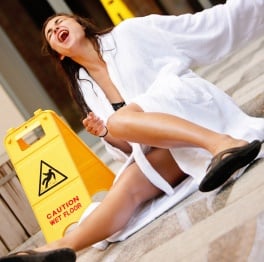Slip and fall coverage is necessary, but what is sometimes overlooked is the importance of a client checklist to stop a claim before it happens.
Owners of business premises are faced with a variety of risks which can lead to crippling losses and, potentially, can result in the failure of the business. A comprehensive insurance program will assist in a recovery, but it will never fully compensate the client for the miscellaneous expenses, lost opportunities and the turmoil that such a loss can cause.
However, by following even a few of these simple and cost-effective loss prevention tips, your client can significantly reduce the chances of suffering a loss by protecting themselves and their customers from slip and falls inside the premises by sharing this simple checklist to clients:
• Inspect the interior of your premises on a regular basis for unsafe conditions that could lead to a slip & fall loss. Maintain a daily log of when the inspection was done, what conditions were noted and what corrective action was taken;
• Floors should be kept clean and in good repair at all times, with loose or defective flooring being replaced immediately;
• Ensure that aisles are kept clear and free of fallen merchandise or stock. (e.g. fruit, vegetables, clothes etc.);
• During periods of inclement weather, all entrances should have mats or rugs to help keep the floor clean and dry. Damaged mats should be replaced as soon as possible;
• Non-slip wax should be used on floor surfaces, where required;
• Water and other spills should be mopped up immediately and a ‘Caution-Wet Floor’ sign should be posted;
• For surfaces that are consistently slippery, specialized non-slip epoxy coatings or non-skid flooring materials may be used;
• For spills involving oil or other industrial materials, absorbent non-combustible cleaning materials should be used; and
• Ensure that all entrance ways and aisles are clear of obstructions and/or promotional displays. (continued.)
#pb#
Looking outside the premises, your client should:
• Inspect the exterior of your premises on a regular basis for unsafe conditions that could lead to a slip & fall loss. Maintain a daily log of when the inspection was done, what conditions were noted and what corrective action was taken;
• Any damage to stairs, sidewalks and pavement should be repaired as soon as possible, with signs and barriers posted, until such time as repairs are completed;
• A snow and ice removal program should be implemented and adhered to, with a single individual having responsibility for the program;
• Have the appropriate equipment, tools and materials available for use by your staff, in the case of a weather related emergency (i.e. shovels, salt, sand etc.);
• Professional snow removal contractors should be contracted to plow, sand and salt your parking and walkway facilities. Ensure that the contractor keeps a comprehensive log of the work performed;
• Clean gutters and downspouts and ensure that melt water is directed away from sidewalks and walkways. Check that exterior lighting is adequate and check on a regular basis for malfunctioning light fixtures; and
• Establish and maintain a daily garbage removal program, whereby the walkways and sidewalks are swept and the debris removed on a regular basis.
Not all slip and falls can be prevented, but sharing a checklist with clients – and more importantly having them follow it – will go a long way to reducing claims and increasing customer satisfaction.


